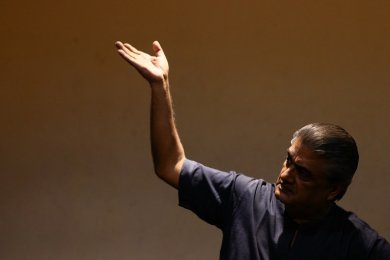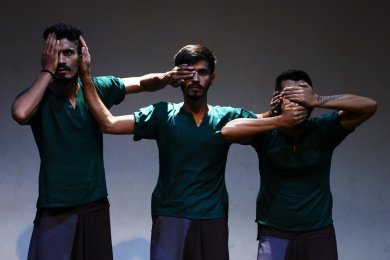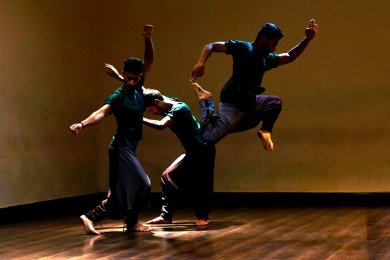
|   |

|   |
|
The Contemporary approach - Madhur Gupta e-mail: madhurgupta04@gmail.com October 4, 2019 It is warm, it is intimate, and it is intense. Events, especially performing arts related, when conducted in baithak styles and as studio presentations, bring out a different flavour than when observed from a proscenium stage. Narenjayan Studio created in memory of late choreographer - student of Uday Shankar - Narendra Sharma under the leadership of his son, seasoned dancer and choreographer Bharat Sharma, presented solo and group compositions titled AGYEYA and TIGDI.  Bharat Sharma AGYEYA being a solo presentation danced by Bharat Sharma himself was a tribute to Hindi poet S.H. Vatsyayana, who was connected with national movement, and a formidable influence on Delhi's literary and cultural life in 60's and 70's. As a soloist, the dancer worked through select poetry in writer's own voice, on various facets of his life's journey and creative insights. Music track had a background of a track of Rudra Veena played by Zia Moinuddin Dagar. It was a pleasure to watch the seasoned dancer break away from the traditional boundaries of what one usually witnesses in and around the contemporary dance scene and acted out the blurted, hazy, yet intense recitation of the poetry with much finesse. Premiered as a new trio choreographed on the music of Steve Reich's 'Music for 18 musicians' composed in mid-70's that was considered a classic of Modern American Music, and re-shaped symphonic structures of Western cassical music, TIGDI performed by Subhasish Dey, Umesh Bisht and Tushar Yadav explored the music through natural gestures, emotions and movements on aspects of friendship, memory, conflicts and individual journeys. The choreographer had worked closely with the dancers in working out a new vocabulary that reflected mundane life and dancers' own stylistic features.   Tigdi On being asked what base the choreographed pieces had, Sharma quite playfully retorted that whenever contemporary dance is presented in India the first thing critics and connoisseurs want to know is the 'Aadhar Card' or the base. He explained how letting go of any set pattern of classical/folk style he delved into exploring the organic flow of the body. However, he stated, 'We did incorporate elements from Chhau, Kalaripayattu, Modern Dance etc.' He emphasised that the pieces were not bound and compartmentalised in any particular style. The interesting fact which one discovered and later the choreographer also revealed was that since TIGDI was supposed to be a trio, the music had tisrajati running parallel all throughout the rendition, which made the reference point of the piece return to its deep Indian roots. And with this, the curtains came down on yet another beautifully curated evening of trending studio performances. Odissi dancer Madhur Gupta is a disciple of Guru Sharon Lowen. He contributes to national dailies like The Hindu, The Times of India, The Asian Age, The Indian Express covering at large the Indian classical dance and music scene of the subcontinent. |